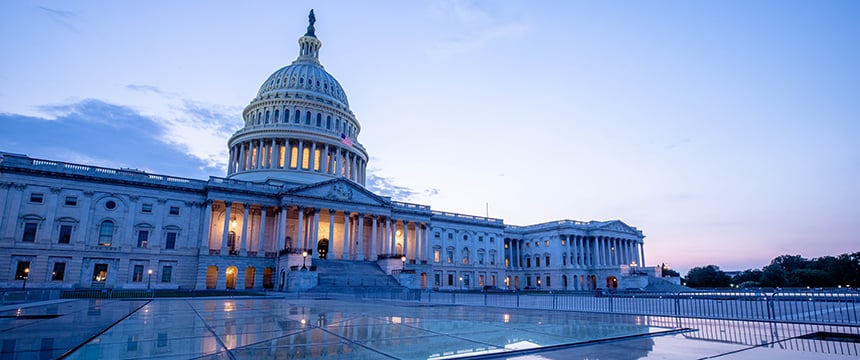Proposed SAFE TO WORK Act Offers Protections to Businesses Impacted by COVID-19

The ongoing COVID-19 pandemic has brought with it a surge of class action lawsuits targeting fitness clubs, entertainment venues, educational institutions, manufacturers of consumer products, and insurance companies, among others. When we last reported on this trend in late July, over 500 new putative class actions related to COVID-19 had been filed. New filings have continued to mount, though relatively few of these cases have concerned instances of harm due to infection.
On July 27, 2020, Sen. John Cornyn (R-TX), together with Senate Majority Leader Mitch McConnell (R-KY), introduced the “Safeguarding America’s Frontline Employees To Offer Work Opportunities Required to Kickstart the Economy Act,” known more commonly as the SAFE TO WORK Act (S.4317). The bill’s stated purpose is to “lessen the burdens on interstate commerce by discouraging insubstantial lawsuits relating to COVID-19 while preserving the ability of individuals and businesses that have suffered real injury to obtain complete relief.”
The SAFE TO WORK Act is part of a $1 trillion COVID-19 relief package introduced by Senate Republicans entitled the Health, Economic Assistance, Liability Protection, and Schools Act (“HEALS Act”) that also includes the following seven bills:
- American Workers, Families, and Employers Assistance Act (S.4318)—“To provide assistance to American workers, families, and employers during the COVID–19 pandemic.”
- Supporting America’s Restaurant Workers Act (S.4319)—“To amend the Internal Revenue Code of 1986 to temporarily expand the deduction for business meals provided at a restaurant.”
- Coronavirus Response Additional Supplemental Appropriations Act, 2020 (S.4320)—“Making emergency supplemental appropriations for the fiscal year ending September 30, 2020, and for other purposes.”
- Continuing Small Business Recovery and Paycheck Protection Program Act (S.4321)—“To establish the Paycheck Protection Program Second Draw Loan and amend the 7(a) loan guaranty program for recovery sector business concerns, and for other purposes.”
- Safely Back to School and Back to Work Act (S.4322)—“To help Americans safely get back to school and back to work, and for other purposes.”
- TRUST Act of 2020 (S.4323)—“To save and strengthen critical social contract programs of the Federal Government.”
- Restoring Critical Supply Chains and Intellectual Property Act (S.4324)—“To facilitate the availability, development, and production of domestic resources to meet national personal protective equipment and material needs, and ensure American leadership in advanced research and development and semiconductor manufacturing.”
In the time since the SAFE TO WORK Act was introduced, its list of co-sponsors has grown to a total of 19 Republican senators. By contrast, the TRUST Act of 2020 has 15 co-sponsors, the Continuing Small Business Recovery and Paycheck Protection Program Act has just one co-sponsor, and each of the remaining bills has zero co-sponsors.
Despite a recent stall in negotiations and the Senate’s adjournment for summer recess, the SAFE TO WORK Act appears to remain a priority for Senate Republicans. Here is what you should know about it:
A New Federal Cause of Action
At its most basic level, the SAFE TO WORK Act (the “Act”) provides various immunities for businesses and would create procedural and substantive hurdles for plaintiffs alleging they became infected with COVID-19 due to commercial or organizational misconduct. In its current form, the Act accomplishes these ends by creating an exclusive federal cause of action for claims of personal injury arising from exposure to COVID-19. Importantly, this new cause of action would preempt state and tribal laws covering the same activity, unless such laws take a stricter approach to the pre-filing requirements and procedural restrictions discussed below. The Act would not preempt intentional discrimination laws or workers’ compensation laws, and does not require that actions be filed in federal court. However, any action filed in state or tribal court alleging injury from exposure to COVID-19 would be removable to federal court based on federal subject matter jurisdiction. Moreover, the reach of the Act would be retroactive to encompass all cases filed on or after December 1, 2019.
Procedural Requirements and Restrictions
The Act would additionally impose various pre-filing requirements on a plaintiff, who would be required to identify all places and persons with whom they had contact two weeks prior to onset of symptoms and state why they believe the defendant is the cause of exposure to COVID-19. Additionally, a plaintiff would be required to verify, under penalty of perjury, the accuracy of the allegations of any complaint filed in or removed to federal court, and to include an affidavit from a non-treating physician who certifies causation, as well as certified medical records documenting the injury.
A number of procedural restrictions would similarly impact the conduct of consumer lawsuits, including putative class actions. Under the Act, class members would be required to affirmatively opt in to be included in the action (rather than be presumptively included and have the opportunity to opt out at a later stage in proceedings, which is more typical), and notices to the class would have to contain express financial disclosures by the attorneys purporting to represent the class. Additionally, special procedures would suspend discovery proceedings pending the resolution of a defendant’s pleading challenges, and discovery would be stayed automatically in the event a motion to dismiss is denied and appealed. If and when discovery proceeds, it would be restricted to matters “directly related to [contested] material issues,” and would be subject to stricter standards where an order to compel discovery is sought by a plaintiff.
Liability Shields
The Act would shield businesses from liability for ordinary negligence connected to COVID-19, and impose liability only upon evidence that a business acted intentionally or with reckless disregard of its legal obligations. To meet the new standard of proof—which would be increased from the “preponderance of the evidence” standard typical in civil litigation to “clear and convincing evidence”—a plaintiff will be required to prove: (1) that the business’ willful misconduct or gross negligence exposed the plaintiff to the virus; (2) that such exposure caused the plaintiff to suffer personal injury; and (3) that the defendant did not make reasonable efforts to comply with applicable government standards and guidance. Even then, the Act presumes that businesses made reasonable efforts if they have a “written or published policy on the mitigation of transmission” that aligns with applicable government standards and guidance. To overcome this presumption, a plaintiff must establish the business was not complying with its policy, or that no such policy existed.
Additionally, health care providers are specifically protected from claims by non-COVID patients who allege their care was impacted as a result of the coronavirus, such as by shifting personnel to cover COVID patients.
Limits on Recovery and Deterrence of Claims
Critically, the Act would limit available remedies to a plaintiff’s recovery of economic losses, as reduced to account for any compensation received from third parties, such as insurance carriers. A plaintiff would be allowed to pursue noneconomic losses only if the court first makes a finding of willful misconduct on the part of the defendant, and even then, punitive damages are limited to the amount of compensatory damages. The shift away from damage multipliers is arguably intended to discourage lawsuits by reducing, if not altogether eliminating, the economic incentive to pursue claims in court.
The Act additionally goes beyond the existing sanctions-related provisions of Rule 11 of the Federal Rules of Civil Procedure by enabling a defendant business to sue for damages, punitive damages, and attorneys’ fees where a plaintiff’s claim (whether that claim was made by suing or merely by a demand letter) is later deemed meritless. Adding to this deterrent effect, the Act allows the U.S. Attorney General to sue law firms, unions, and others engaged in a pattern or practice of seeking compensation for similar violations.
Conclusion
While the entirety of the HEALS Act continues to face an uphill battle in the Senate, the SAFE TO WORK Act—or some iteration thereof—would, if adopted, provide significant procedural and substantive protections to businesses already facing the dramatic effects of the pandemic. Those protections would likely overlap with those offered by states like Georgia, whose governor recently enacted the Georgia COVID-19 Pandemic Business Safety Act. That law, like those enacted in Louisiana, Oklahoma, North Carolina, and several other states across the country, as well as other federal efforts like the energizing of the PREP Act, seeks to alleviate the burdens faced by businesses in protecting their customers and employees from exposure to COVID-19.
Companies in all sectors of the economy continue to be impacted by COVID-19. Foley is here to help our clients effectively address the short- and long-term impacts on their business interests, operations, and objectives. Foley provides insights and strategies across multiple industries and disciplines to deliver timely perspectives on the wide range of legal and business challenges that companies face conducting business while dealing with the impact of the coronavirus. Click here to stay up to date and ahead of the curve with our key publications addressing today’s challenges and tomorrow’s opportunities. To receive this content directly in your inbox, click here and submit the form.


